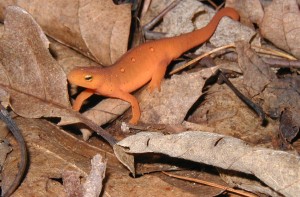While out looking for wintergreen plants during the morning hours one day in July, this orange salamander crossed my path. I wasn’t walking on a trail, but rather traipsing through the oak-hickory-maple woodlands on a mountain ridge in Pennsylvania. What a cute little salamander! It’s very unusual to see a salamander outside of their hiding places, but if you do see one it’s most likely the Red Eft.
Red Efts are the terrestrial phase of the Red-Spotted Newt, Notophthalmus viridescens viridescens, who usually can be found in ponds or other slow-moving water. The life cycle of this salamander is typical of amphibians who need access to water as well as land. The land must be damp or moist, so they don’t stray far from a source of water. The source of water that this particular red eft came from was likely a small pond about an 1/8th of a mile down the lane.

We see dark-colored newts hanging in the pond until they are startled or gulp a breath of air before submerging. The aquatic phase is dark brown or russet with red spots.
It was a joy to see this little gal tramping around in the woods. There are some gigantic bullfrogs at the pond and lots of their carnivorous tadpoles, so I’ve wondered about the newts’ ability to evade their predators. Leaving the pond for a year or three is part of their strategy to survive. The terrestrial or land form of newts has a bad-tasting chemical in their skin secretions that wards off birds and mammalian predators.

As to the sex of the red eft, one can’t be sure as they haven’t transformed into adults yet. The Red-Spotted Newt life cycle begins and ends in a small body of water, like a pond, ditch or temporary vernal pool. The aquatic larval stage spends the first few months in the water until it reaches the transforming stage. During its transformation the aquatic salamander attains the ability to breathe atmospheric air so that it can live on land. The transforming phase is dark in color, but otherwise looks just like the red eft.
When the transformation is complete, it’s ready to leave the water and go about on land as the red eft, or land form of the newt. The newt will find a new or its birth pond in one to three years and mature into an adult female or male. Adults are yellowish-brown or greenish-brown with dark spots. Males are differentiated from females by a high dorsal fin on their tail. The tails of the transforming phase and the red eft are nearly round in cross-section. When in breeding condition the males will have black horny growths on their hind legs and toes that the females lack.
Roger Conant makes an interesting statement in the Reptile and Amphibian Peterson Guide about the boldness of the Red Efts in exploring their terrestrial territory.
The terrestrial efts, although avoiding direct sunlight, are extraordinarily bold, often walking about in the open on the forest floor in broad daylight. After summer showers in mountainous regions they sometimes may be seen by scores or even hundreds.
I can certainly vouch for seeing one terrestrial eft in broad daylight, but I wonder where scores of them have been seen at one time. Has anyone seen such a sight?
Thanks for the post.. my son and I found about 20 in a half hour during a light summer rain in the Pocono Mountains of Pennsylvania. I’m sure if we were really searching for them we could have found 100
That is so cool, Paul! Thanks for sharing your PA mountain experiences. The next time I see one I’ll definitely be searching for other red efts in the vicinity. I haven’t seen another since then, but for the longest time the little guy was the screensaver on my laptop.